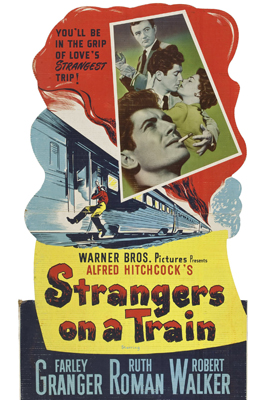On Netflix before August ends, you can celebrate Alfred Hitchcock’s 120th birthday by watching one of his best films. Easily his most entertaining and accessible movie, “Strangers on a Train” speeds along like a powerful locomotive. If you’ve ever wondered why Hitchcock is so revered as an influential filmmaker, some of the shots and sequences in “Strangers” will answer that for you.
But it’s the story that grabs you with the slick premise of two men involved in setting up the perfect murder: one’s a normal ‘Joe’ (Farley Granger); the other’s a Class-A psychopath (Robert Walker). While the psychopath weaves the web, we watch the unknowing normal guy try to free himself from it.
Hitchcock’s opening sequence shows his skill- two sets of shoes board a train. One pair is plain brown; the other white with black accents. Sitting across from each other in one of the train cars, brown shoes crosses his legs accidentally hitting white shoes. An apology begins the conversation between the two men. Brown shoes is Guy Haynes (Granger), a celebrity tennis player on his way to his hometown to give money to his estranged wife Miriam (Kasey Rogers) for a long-discussed divorce. The flashy white shoes are Bruno Antony (Walker), who recognizes Guy from the gossip pages. He knows Guy has been dating Ann Morton (Ruth Roman), a senator’s daughter, and his divorce from Miriam would clear the way for Guy and Ann to marry.
Learning of Guy’s amicable intent to pay Miriam’s lawyer’s fees for the divorce, Bruno’s disappointed. Under the thumb of his wealthy father, Bruno explains a perfect murder plan that would have gotten both Miriam and Bruno’s father out of the way: Guy and Bruno could kill the other guy’s problem person: no link, no motive. Bruno cutely calls his plan ‘criss-cross.’
When Guy sees Miriam, he gets a ‘double-cross’- Miriam won’t divorce him. Guy tells Ann the bad news and gets more bad news when Bruno calls to see how Guy made out. Upon learning of Miriam’s betrayal, Bruno decides to pay her a visit. ‘Criss-cross.’
“Strangers on a Train” contains a common theme in Hitchcock films- an implicated man trying to prove his innocence. Whether in “Saboteur” or “North by Northwest, it’s something Hitchcock did well. In “Strangers,” Guy is left trying to circumvent Bruno’s actions. He can’t go to the police, he’d be an accessory before the fact. With such a powerful motive, any harm to Miriam makes him the prime suspect. Any scandal would have political implications for Ann’s father. Guy trying to figure out his next move while Bruno’s running around only strengthens Hitchcock’s ‘master of suspense’ title.
How well this sordid business plays out is bolstered by its writing. “Strangers” screenplay was co-written by Raymond Chandler (author of the Philip Marlowe detective novels like “The Big Sleep” and “Farewell, My Lovely”) and is based on the novel by Patricia Highsmith, who wrote another great book about an equally clever psychopath with “The Talented Mr. Ripley.”
Highsmith knows deviants and Bruno Antony’s a gem. For me, Robert Walker’s acting is the best thing about “Strangers.” Walker’s Bruno is a gregarious man-child, full of bad ideas and a juvenile nature. He admires people who’ve achieved things in life because his only ambition is to comfortably leech off his family’s wealth. His mother dotes on him, manicuring his nails and laughing off his oddball ideas like blowing up the White House. Bruno cheerfully shows his vanity by wearing a tie-clasp that bears his name. However, when things don’t go his way or he’s determined to make some misguided mayhem, Walker gives Bruno a face of stone as solid as his performance- it’s an iconic portrayal of the abnormal. So give Hitchcock his due before September. Even if you’ve seen “Strangers on a Train” before, it’s worth revisiting just to remember why some movies, and their directors, are timeless.

